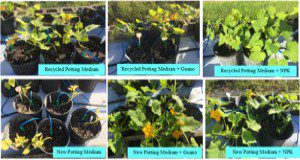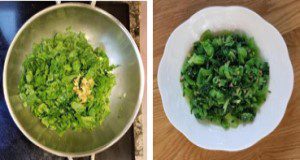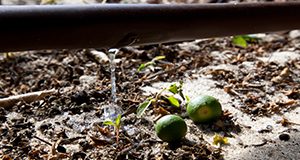Lettuce Downy Mildew (LDM), caused by the oomycete Bremia lactucae, is the most important disease of lettuce worldwide. LDM has a direct effect on both yield quantity and quality because it may infect lettuce at any growth stage, affecting the marketable portion of the crop. This new 6-page publication of the UF/IFAS Horticultural Sciences Department introduces the LDM disease in Florida lettuce and available control methods and strategies. This publication also introduces the work on LDM in the UF/IFAS Lettuce Breeding Program, which was created to release cultivars adapted to Florida conditions. Written by Lis Rodrigues-Porto, Richard N. Raid, and Germán V. Sandoya.
https://edis.ifas.ufl.edu/hs1403
Category: Agriculture
Use of Recycled Potting Medium for Containerized Production of Squash
Vegetable growers are keen on cost-cutting measures to increase profitability. Containerized vegetable production can be done in a shade-house or garden, and it often requires commercial potting media. Although expensive, potting media are lightweight and provide high water- and nutrient-holding capacities, and thus they are widely used by growers. Growers often discard or compost the potting media after a single season due to issues such as diseases, pests, and weeds. However, old potting media could be reused for containerized production if appropriately sterilized and amended with fertilizer salts. The current study was conducted to determine the feasibility of using sterilized recycled potting medium amended with fertilizer salts for containerized production of squash. This new 4-page publication of the UF/IFAS Horticultural Sciences Department was written by Marie Dorval, Riphine Mainviel, Vincent Michael, Yuqing Fu, Bala Rathinasabapathi, and Geoffrey Meru.
https://edis.ifas.ufl.edu/hs1404
Transitioning from Conventional to Organic Farming Using Conservation Tillage
Organic farming is one of the fastest-growing segments of the agricultural industry in the United States and in Florida. Conservation tillage is often employed to reduce soil erosion, improve physical and biological properties of soil, and increase water use efficiency. This 5-page article aims to provide recommendations to row crop farmers who wish to implement conservation tillage practices during their transition to a certified organic system. Written by D. L. Wright, J. Moyer, D. Treadwell, I. M. Small, and S. George, and published by the UF/IFAS Agronomy Department, revised November 2020.
https://edis.ifas.ufl.edu/ag246
Nematode Management in Cole Crops
Many different plant-parasitic nematodes cause yield loss in cabbage, broccoli, collards, and other valuable Florida cole crops. This 13-page fact sheet written by Z. J. Grabau and J. W. Noling and published by the UF/IFAS Entomology and Nematology Department lists common symptoms, explains how to submit samples to a nematology lab such as the UF Nematode Assay Lab for diagnosis, and describes key cultural practices to help agricultural professionals spot and manage nematode problems in cole crops.
https://edis.ifas.ufl.edu/ng024
Soil Health Response of Histosols to Flooded versus Dry-Fallow Conditions during Summer
Evaluating changes in soil properties associated with flooded fields during the summer months in the Everglades Agricultural Area (EAA) provides us an opportunity to assess the effect of soil management associated with flooded versus dry-fallow field conditions on Histosols. This information will be beneficial to current and potential growers farming flooded rice in south Florida, as well as Extension agents who work on rice and soil conservation agencies such as the USDA Natural Resources Conservation Service (NRCS). This new 6-page publication was written by Jehangir H. Bhadha, Jay Capasso, Abul Rabbany, Nan Xu, and Matthew VanWeelden, and published by the UF/IFAS Department of Soil and Water Sciences.
https://edis.ifas.ufl.edu/ss697
Organic Blueberry Production in Florida
There is a growing market in the United States and globally for fresh fruits and vegetables with reported health-enhancing properties. This includes blueberries, which are high in antioxidants and have been reported to improve heart health and contain anticancer properties. Fresh-market blueberry sales (conventional and organic) increased by 27% between 2013 and 2017, and that trend is expected to continue. In addition, there is an increasing level of consumer interest in organically grown produce (for environmental conservation, taste, and other perceived benefits), for which some consumers are willing to pay a premium over the price for a conventionally produced crop. This new 8-page publication of the UF/IFAS Horticultural Sciences Department discusses various aspects of organic blueberry production in Florida and is intended for use by those currently using or interested in pursuing organic production. Written by Douglas A. Phillips, Peter J. Dittmar, Philip F. Harmon, Oscar E. Liburd, Danielle D. Treadwell, and Jeffrey G. Williamson.
https://edis.ifas.ufl.edu/hs1400
Chinese Mustard Cultivation Guide for Florida
Chinese mustard is a nutritious leafy vegetable in the family Brassicaceae. Chinese mustard also goes by many common names, such as brown mustard, mustard greens, leaf mustard, Indian mustard, Oriental mustard, and vegetable mustard. Although it is considered a weed in a few states, such as Michigan, this species is not listed as invasive in Florida and has been cultivated in several counties, including Levy, Palm Beach, and Miami-Dade. This new 8-page publication of the UF/IFAS Horticultural Sciences Department provides a short cultivation guide as well as information on the uses and marketability of Chinese mustard. Written by Yuheng Qiu, Mary Dixon, and Guodong Liu.
https://edis.ifas.ufl.edu/hs1402
Management Options for Improving Flowering in Citrus Production
The final fruit yield and, ultimately, returns a grower receives from any given harvest is directly related to the number of viable flowers that are generated and the proportion of those flowers that produce fruit. A grower can improve the ability for their trees to consistently produce a profitable crop of fruit by understanding the steps involved in flowering and controlling the transition to reproductive growth. This new 6-page publication of the UF/IFAS Horticultural Sciences Department was written by Leigh Archer, Miurel Brewer, Bikash Adhikari, Eduardo Esteves, Christopher Vincent, and Tripti Vashisth.
https://edis.ifas.ufl.edu/hs1399
Prácticas Culturales para el Caqui Japonés en Florida
Los caquis son considerados como un cultivo relativamente sostenible en Florida, con una calificación de 6 puntos en una escala de 10 para la evaluación de sostenibilidad agrícola. Los caquis tienen un potencial comercial moderado y altas probabilidades de llegar directamente al consumidor. La demanda de los consumidores podría ser de cultivares no astringentes principalmente. Los caquis son aptos para el centro y el norte de Florida, ya que la calidad y los rendimientos pueden ser bajos en la parte sur del estado.
This new 15-page publication of the UF/IFAS Horticultural Sciences Department is the Spanish translation of HS1389, Japanese Persimmon Cultural Practices in Florida, written by Ali Sarkhosh, Dustin M. Huff, and Peter C. Andersen, and translated by Jonathan Clavijo-Herrera.
https://edis.ifas.ufl.edu/hs1401
Common Hazards Associated with Sheep and Goat Feed
This 7-page document provides a list of common hazards to consider in the manufacturing of feed for small ruminants. Written by Chalise Brown, Diwakar Vyas, and Jason M. Scheffler, and published by the UF/IFAS Department of Animal Sciences, November 2020.
https://edis.ifas.ufl.edu/an363
Crop Water Use and Irrigation Scheduling Guide for North Florida
Effective irrigation scheduling enables the irrigator to apply the right amount of water at the right time to meet the crop water demand. This 19-page guide presents information on average daily and weekly crop water use and crop growth stages for twelve north Florida crops that can be used to help schedule irrigation. This will allow a grower to develop a realistic irrigation schedule that minimizes plant water stress, saves water, and reduces nutrient leaching potential. Written by Vivek Sharma, Charles Barrett, De Broughton, and Thomas Obreza, and published by the UF/IFAS Department of Soil and Water Sciences, revised December 2020.
https://edis.ifas.ufl.edu/ss491
Boom Sprayer Calibration Tables
This 13-page publication is meant to make calibration of boom sprayers easier, and therefore more common, by providing a convenient chart that can be kept in barns, tractor cabs, sprayers, and mix-load facilities for quick reference. Written by Michael J. Mulvaney, Pratap Devkota, Ethan Carter, De Broughton, and Mark Mauldin, and published by the UF/IFAS Agronomy Department, November 2020.
https://edis.ifas.ufl.edu/ag446
Consejos Basicos para Disenar Sistemas Eficientes de Riego
Este documento provee un panorama básico de los factores más importantes al diseñar. Written by Haimanote K. Bayabil, Kati W. Migliaccio, Michael Dukes, Laura Vasquez, and Carlos Balerdi, and published by the UF/IFAS Department of Agricultural and Biological Engineering, December 2020.
https://edis.ifas.ufl.edu/ae549
Constructing a Southwest Florida Tomato Enterprise Budget
Enterprise budgets are effective planning tools for growers in search of help with forecasting, resource coordination, and better production decisions. In essence, enterprise budgets can help producers determine what to produce, how many acres to produce, the cost of production, and the necessary price to be profitable. This 5-page fact sheet written by Tara Wade, Barbara Hyman, Eugene McAvoy, and John VanSickle and published by the UF/IFAS Food and Resource Economics Department describes the process used to create the 2017/18 enterprise budget for tomatoes in southwest Florida and includes resources for producers interested in creating enterprise budgets for their own operations.
https://edis.ifas.ufl.edu/fe1087
Bees of Florida
Did you know there are over 320 species of bees in Florida and over 4,000 in the United States? Wild bees vary widely in behavior, color, size, and shape. Written by James R. Weaver, Shiala M. Naranjo, Emily Noordyke, and Rachel E. Mallinger and published by the UF/IFAS Entomology and Nematology Department, Bees of Florida is a two-page pdf guide to some common bee groups and species you may encounter in Florida.
https://edis.ifas.ufl.edu/in1285
Yaupon Holly Culture and Pest Management for Tea Production and Ornamental Use
Yaupon holly, Ilex vomitoria Aiton, is an evergreen woody plant native to the southeastern United States. The species is widely used as a landscape ornamental plant because it tolerates a wide range of soil and environmental conditions, is available in various forms, and attracts wildlife, especially native birds. Recently, there has been a resurgence of interest in cultivating the plant for the caffeinated beverages that can be made from its leaves. This 8-page fact sheet written by Matthew A. Borden, Mark A. Wilhelm, and Adam G. Dale and published by the UF/IFAS Entomology and Nematology Department provides a guide to managing yaupon holly and protecting it from pests. It will be useful to both commercial growers and homeowners interested in growing this beautiful and useful plant.
https://edis.ifas.ufl.edu/in1299
Blackberry and Dewberry: Biology and Control
Blackberry and dewberry are often viewed as nuisance weeds that reduce grazing in a portion of the pasture. However, severe financial losses can occur if these growing thickets injure cattle. This 4-page document provides information regarding blackberry and dewberry management in pastures. Written by Brent Sellers, Pratap Devkota, and Jason Ferrell, and published by the UF/IFAS Agronomy Department, revised November 2020.
https://edis.ifas.ufl.edu/ag238
How to Structure Data from an IoT Monitoring Network
The Internet of Things, or IoT, refers to the billions of physical devices that collect and share data through the Internet. This 5-page publication discusses the typical attributes in IoT monitoring networks and presents a data structure that outlines best practices in organizing data. Written by Ziwen Yu, and published by the UF/IFAS Department of Agricultural and Biological Engineering, November 2020.
https://edis.ifas.ufl.edu/ae548
How Is Our Future Climate Projected?
Climate is the long-term patterns and fluctuations in air and moisture. This 5-page article explains how future climate is projected using mathematical models and introduces common scientific terms used when discussing climate change. Written by Young Gu Her, Zachary Brym, Ashley Smyth, and Elias Bassil, and published by the UF/IFAS Department of Agricultural and Biological Engineering, November 2020.
https://edis.ifas.ufl.edu/ae546
Pintoi Peanut: A Seed-Propagated Perennial Peanut Forage Option for Florida
Because of its adaptability to Florida's environmental conditions and ability to produce viable seeds, pintoi peanut represents an interesting forage alternative for cow-calf producers in the state. This 5-page document provides current information on pintoi peanut for forage and livestock producers in Florida. Written by Joao M. D. Sanchez, Joao Vendramini, Maria L. Silveira, Jose C. B. Dubeux Jr., Lynn E. Sollenberger, and Philipe Moriel, and published by the UF/IFAS Agronomy Department, November 2020.
https://edis.ifas.ufl.edu/ag445


















